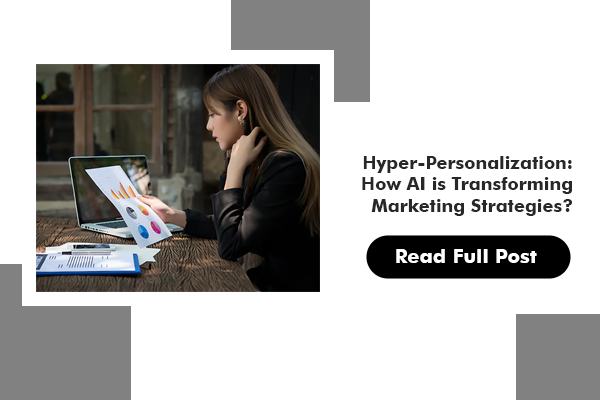Have you ever received an email or ad that felt like it was crafted just for you? A recommendation is so precise it makes you wonder if your mind has been read. The era of hyper-personalization in marketing is increasing, where Artificial Intelligence (AI) is revolutionizing how brands connect with their audiences.
As consumers demand more tailored experiences, businesses are leveraging AI to create marketing strategies that resonate deeply, improve engagement, and boost conversions. Let’s explore the transformative power of hyper-personalization and how AI is reshaping the marketing landscape.
Decoding Hyper-Personalization
Hyper-personalization goes beyond basic segmentation and demographic-based targeting. It involves using AI, machine learning, and real-time data to deliver highly customized content, products, or services to individuals at the right time, and on the right platform.
Unlike traditional personalization, which may group consumers by age, location, or preferences, hyper-personalization analyzes behaviors, purchase histories, browsing habits, and even contextual data (like weather or location) to craft unique experiences for each user.
The Role of AI in Hyper-Personalization
AI powers hyper-personalization by automating the analysis of vast datasets and identifying patterns that would be impossible for humans to discern. Here’s how AI transforms key aspects of marketing:
Data Analysis at Scale
AI can process millions of data points from diverse sources such as social media, browsing activity, and purchase behavior. By understanding these patterns, AI helps marketers predict what consumers want, even before they know it themselves.
Real-Time Customization
AI allows businesses to adapt their messaging instantly. For example, an e-commerce platform might suggest different products to a user based on their browsing behavior in real-time.
Dynamic Content Creation
AI-driven tools like natural language generation (NLG) create personalized emails, ads, and even chatbot responses tailored to each consumer’s preferences.
Predictive Analytics
AI predicts future consumer behavior, enabling businesses to anticipate needs and proactively offer solutions. For instance, streaming platforms suggest shows based on what users are likely to enjoy next.
Applications of Hyper-Personalization Across Industries
E-commerce
E-commerce giants are masters of hyper-personalization. From “Customers also bought” suggestions to personalized homepages, AI ensures every customer interaction is relevant and engaging.
Healthcare
Healthcare providers use AI to send tailored health tips or medication reminders based on patient history and conditions, creating a more connected and personalized care experience.
Retail
Physical retail is embracing AI to hyper-personalize in-store experiences. Smart mirrors, for example, can recommend outfits based on a customer’s past purchases or preferences.
Banking and Finance
Financial institutions use AI to offer customized investment plans, fraud alerts, and spending insights tailored to each client’s financial goals and history.
Entertainment and Media
Streaming platforms rely on AI algorithms to create hyper-personalized playlists and recommendations, ensuring users remain engaged.
Benefits of Hyper-Personalization
Enhanced Customer Engagement
By delivering content that aligns perfectly with user preferences, brands foster stronger emotional connections and increase engagement rates.
Improved Conversion Rates
Tailored recommendations make consumers feel understood, increasing the likelihood of a purchase or subscription.
Customer Retention
Hyper-personalized experiences build loyalty. Customers are more likely to stay with a brand that consistently meets their individual needs.
Optimized Marketing ROI
AI reduces wasted ad spend by ensuring marketing efforts target the right audience with the right message at the right time.
Challenges in Implementing Hyper-Personalization
Data Privacy Concerns
Consumers are increasingly wary of how their data is collected and used. Businesses must ensure transparency and comply with government regulations.
Data Silos
Fragmented data across different departments or systems can hinder the effectiveness of AI-driven hyper-personalization.
Over-Personalization Risks
While personalization enhances experiences, overdoing it can feel invasive or “creepy,” pushing customers away instead of drawing them closer.
Technological Barriers
Implementing AI-driven systems requires significant investment in infrastructure, talent, and technology.
The Future of Hyper-Personalization
The future of marketing lies in the seamless integration of AI and hyper-personalization, paving the way for highly engaging customer experiences. Emerging technologies are driving this evolution by making interactions more immersive, intuitive, and tailored to individual preferences.
Augmented Reality (AR) is enabling virtual try-ons and immersive shopping experiences, allowing customers to visualize products in real time, bridging the gap between digital and physical shopping. Voice AI is revolutionizing customer engagement by delivering personalized responses and recommendations through smart assistants, creating a more conversational and efficient interaction. Meanwhile, AI-powered chatbots are providing real-time, hyper-personalized support, addressing user queries instantly and effectively.
This evolution not only enhances customer satisfaction but also fosters deeper connections, positioning brands as partners in their customers’ journeys rather than just service providers.
Conclusion
Hyper-personalization, powered by AI, is transforming the way brands engage with their audiences. By leveraging data intelligently and responsibly, businesses can create experiences that feel personal, relevant, and timely.




